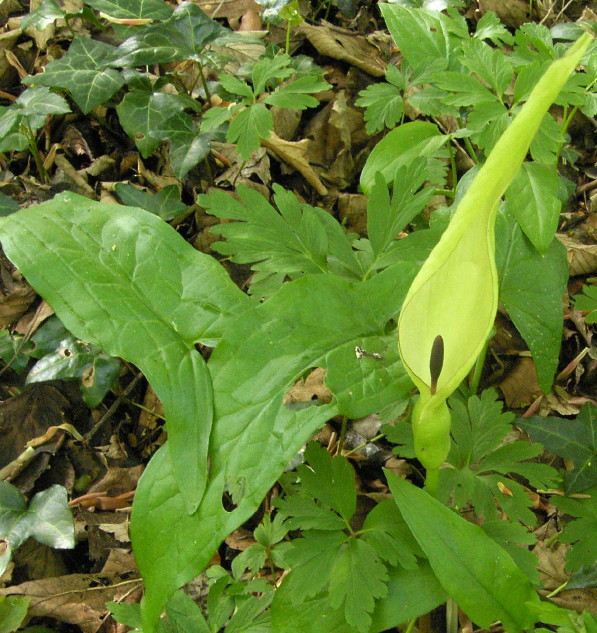Lords-and-ladiesScientific Name: Arum maculatum |
Lords-and-ladies is a bulbous perennial in the Araceae Family, common to damp woodlands and hedge banks. Another common name, Cuckoo Pint is believed to have arisen because the flower appears around the time the cuckoo arrives and the 'pint' part is descriptive of the spadix said to resemble the penis or "pint" shortened from "pintle". Lords-and-ladies is also descriptive coming from the shape of the spadix and the outer spathe that covers it resembling the union of the male and female genitalia.
The broad, bright green, arrow-shaped leaves start into growth in spring, sometimes they have dark spots.
Between April and May the flowers appear. The spathe has a pale green, sheath-like bract surrounding the inner spadix which carries the male and female flowers that are enclosed at the bulbous base. The cream-coloured female flowers are at the bottom, above them the small red male flowers which are below a ring of sterile flowers with hair-like extensions which temporarily trap the insects that do the pollination. They are attracted by the foul smell generated by the raised temperature of the spadix which can be up to 15°C above the surroundings. Later in the autumn the leaves, the outer spathe and top of the spadix have withered and the remaining stalk carries a cluster orange to bright red berries that have developed from the fertilised female flowers. These have an acrid taste and cause tingling in the mouth so tend not to be eaten in large enough quantities to cause harm. If swallowed they cause swelling of the throat, difficulty breathing, a burning pain and an upset stomach.
The tuberous root has been used to prepare a beverage called saloop in the past before the availability of tea and coffee. It was well roasted and ground to prepare an infusion, but due to its toxicity great care would be required with the preparation.
There have been a number of medicinal uses in the past and Culpepper lists some including the crushed fresh or dried leaves to draw the poison from boils or plague-sores, powdered root with sugar to ease breathing or in wine as a diuretic. The only modern use is for a Homeopathic preparation to treat respiratory conditions.
Nicholas Culpepper
(17th century astrologer-physician)
"The berries or roots beaten with hot ox-dung, and applied, easeth the pains of the gout"
